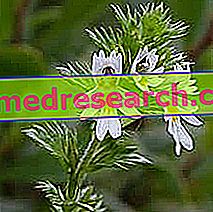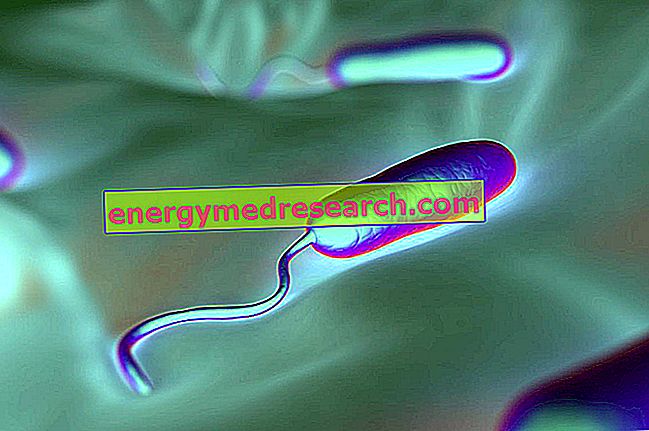
Scientific name
Euphrasia officinalis - Synonyms: Eosthrasia rostkovianaFamily
Broomrape family
Origin
Cosmopolitan distribution. Common in meadows, pastures and spots, from the plain to the alpine area throughout northern and central Italy, rare in southern Italy
Used Parts
Whole flowering plant, without roots
Chemical constituents
- Flavonoids: 0.38%: apigenin, luteolin, kampferol, ramnetin, quercetin
- Polyphenols: 1.47%;
- Phenolic acids: caffeic acid and derivatives, chlorogenic acid and derivatives
- Hydrocinnamic derivatives: 1.97%
- Tannins
- Iridoids: aucubine 0.05%
Eufrasia in Herbalist: Euphrasia property
Decongestant, stomachic, bitter-tonic, astringent, anti-inflammatory, ocular and antiallergic properties.
Euphrasia is widely used for washing and eye packs in the presence of conjunctivitis and blepharitis.
Throughout Europe, the euphrasia has a wide and widespread tradition of popular use in the treatment of eye diseases; the relief from these affections was a cause of great joy, hence the scientific name (from the Greek euphrasia = gaiezza ) and the numerous popular appellatives (in English the plant is known as Eyebright = bright eye, while in France one speaks of Casse-Lunettes = brain glasses ).
Biological activity
As mentioned, the eyebright is a plant endowed with an anti-inflammatory activity that is expressed above all at the ocular level. For this reason, the plant is frequently used in eye drops or eye packs, to be used in the case of conjunctivitis, blepharitis or other eye diseases (a use that however has not been officially approved).
The antiphlogistic action exercised by Euphrasia is attributable to the aucubine contained in it.
Furthermore, this molecule has been shown to exert a hepatoprotective activity against damage caused by carbon tetrachloride poisoning and alpha-amanitin, but not only. In fact, some in vitro studies have also shown that aucubine is able to inhibit the hepatitis B virus. However, before being able to approve similar medical applications of the eyebright, it is necessary to conduct further and more in-depth studies .
Finally, the eyebright is also used in case of colds, rhinorrhea and hay fever (for more information on this, see the "Employment" paragraph).
Eufrasia in folk medicine and homeopathy
The anti-inflammatory properties of eyebright have long been known to folk medicine, which uses this plant precisely for the treatment of conjunctivitis, blepharitis, sties, eye fatigue, eye disorders of muscular or nervous origin, cough and hoarseness.
Euphrasia is also widely used in the homeopathic field, where it can be found in the form of granules, oral drops and eye drops.
Homeopathic medicine uses this plant in case of allergic rhinitis, conjunctivitis, excessive watering, irritation, burning and eye redness.
The amount of homeopathic remedy to be taken can be different from individual to individual, also depending on the type of disorder that needs to be treated and according to the type of preparation and homeopathic dilution that is intended to be used.
Loans
Euphrasia is widely used for eye washes in the presence of diseases such as conjunctivitis, blepharitis, orzaioli ...
For external use it is also used as eye drops in cases of eye disorders: fatigue phenomena, burning, photophobia, sties, blepharitis ...
Finally, its use is suggested as a nasal ointment in the presence of rhinorrhea.
Euphrasia infusion is used for external use at 2-3% in the form of compresses to calm inflamed eyes. In this regard, a tablespoon of dried plant is infused in a cup of boiling water, left to cool and the eyes are washed 2 or 3 times a day. You can also dip a cloth and place it on your eyes, massaging slightly. Often, for similar applications, the eyebright is associated with plants rich in mucilage and / or with an anti-inflammatory and decongestant action (eg Chamomile, Melilotus, Plantain).
| Ocular Lavender - Recipe | |
| Eufrasia (leaves) | 60% |
| Melilotus (leaves) | 20% |
| Plantain (aerial parts) | 20% |
A soup spoon of mixture (dried in herbal tea) in a cup of boiling water. After 15 minutes of infusion, filter with a sterile gauze and apply in the form of eye packs. NOTE: prepare a fresh solution each time. | |
Euphrasia is also used for fumigations against colds, rhinorrhea and hay fever, and as a mouthwash against sore throats and stomatitis. In this sense, it is associated with plants rich in essential oils such as eucalyptus and peppermint for fumigations, and plants rich in mucilage for mouth rinses.
| Infusion for Suffumigi - Recipe | |
| Eucalyptus (leaves) | 50 g |
| Peppermint (leaves) | 25 g |
| Eufrasia (aerial parts) | 25 g |
4% infusion (four grams of mixture per 100 ml of water): bring the water to a boil, pour it over the mixture, boil for a couple of minutes and inhale the hot vapors, wrapping the head and forehead with a towel to don't waste them. Do 5 or 6 fumigations a day. | |
Euphrasia also has a wide use in homeopathic medicine, where it finds the same applications at an ocular level.
Contraindications
Euphrasia is a well tolerated plant. Particular attention must be paid to cases of established hypersensitivity to one or more components of the drug.



